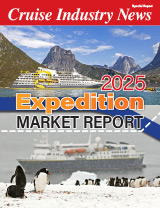 Further diversification of homeports and cruise lengths continue at Royal Caribbean International and Celebrity Cruises, according to Jamie Haller, director of deployment and itinerary planning.
Further diversification of homeports and cruise lengths continue at Royal Caribbean International and Celebrity Cruises, according to Jamie Haller, director of deployment and itinerary planning.
“The most significant development at Royal Caribbean in 2005,” he said, “is our expansion in the Northeast and our continuing diversification of cruise lengths. We now have regular sailings ranging from three to 11 days and up to 14 days when you include our more exotic programs.”
Celebrity meanwhile will have an unprecedented four ships in Europe this summer, two of which will be in Northern Europe – the first time ever that Celebrity has had more than one ship in the region.
“If you look at both brands, you will see that Royal Caribbean has consolidated more while Celebrity has expanded to South America, the Galapagos and next year to Asia and the South Pacific,” Haller explained.
“Royal has a tremendous set of itineraries,” he continued, “but the brand position has moved a little bit away from where it used to be. We have no Royal Journeys anymore, for instance.”
Haller said that the company plans up to five to 10 years ahead, although nothing specific beyond two-and-a-half years. This spring he is looking at summer 2007.
Many variables play into the planning process, according to Haller, who added that the bigger the dollar value involved, the more attention it gets. But while tickets and onboard spending produce revenue right away, guest satisfaction – which is the ultimate goal of itinerary planning – tend to pay off in the long term, when passengers come back and when word-of-mouth generates new passengers.
As new ships have been introduced, the brands have added new itineraries – but not necessarily for the new ships. Instead, new capacity helps drive established programs – keeping them fresh and marketable. Meanwhile, existing ships are used to explore new itineraries.
Haller said that the new Freedom of the Seas will be deployed on alternating Eastern and Western Caribbean itineraries. “There are many ports that can handle the ship,” he said. “We are looking at our options.”
Added John Tercek, vice president of commercial development: “Many ports expand and upgrade on their own initiative. The driving force has been the bigger ships.
“Some ports build for tomorrow while others build the future,” he pointed out, noting that all Florida ports are doing upgrades.
“We are sailing from some 18 deepwater ports in North America, and I expect that eventually all deepwater ports here will have cruise traffic.”
Royal Caribbean has also taken port initiatives and opened its own facility in Bayonne, New Jersey last year, serving the metropolitan New York market. “Bayonne received the highest ratings among the ports we used in 2004 in terms of customer satisfaction,” Tercek said. “Even if it was just a converted warehouse, we were very pleased.”
This year the Bayonne ownership will be modified. Royal Caribbean will retain preferential rights but will not have ownership. Tercek noted that there are “lots of ports we have agreements with.”
In Europe, Royal Caribbean has a minority interest and operating rights in Kusadasi and what Tercek called a “pending venture in Civitavecchia with MSC Cruises and Costa Crociere,” which he said was not a done deal yet.
Another project is underway in Belize.
Continued Haller: “Experienced cruisers tend to appreciate longer sailings with more sea-days, while first timers are attracted more by shorter cruises and by well-known names. They need to see destinations that they recognize.
“We basically balance marquee ports and new ports largely in proportion to new and past guests. Thus, we are always hunting for new destinations,” he added.
The Legend of the Seas and the Splendour of the Seas are considered Royal Caribbean’s pathfinder ships – used to test new programs. Haller said they are small enough, have balcony cabins and are also the fastest ships in the fleet. And this summer, the Legend will sail from Southampton offering cruises marketed in the U.K. before transferring to Tampa for the winter season.
Haller estimated that the brands will have some 300 different itineraries in 2005.
Even though cruise lengths vary, most cruises still depart on weekends. “We are geared to consumer preferences,” he added. “While people may want to spend more time in port, we need to counterbalance that with the overall cruise experience. People tend to come back before dinner; they like the experience of sailing out at sunset; and they like the evening shipboard activities and entertainment.”
For new ports to be considered, they must be in the right location in the first place, according to Haller. They must also have a product and be able to cater to passengers who do not go on shore excursions but also need something to do. And they must satisfy the lines’ requirements for safety and security.
The cost and revenue structure also plays in.
The bottom line is that Haller needs to demonstrate why the ships should call at a new port instead of an existing port.
As industry growth slows down, Haller pointed out, there will be more onus on destinations to perform as the cruise lines must continue to improve profitability. – Oivind Mathisen
Excerpt from the Cruise Industry News Quarterly Magazine: Spring 2005



